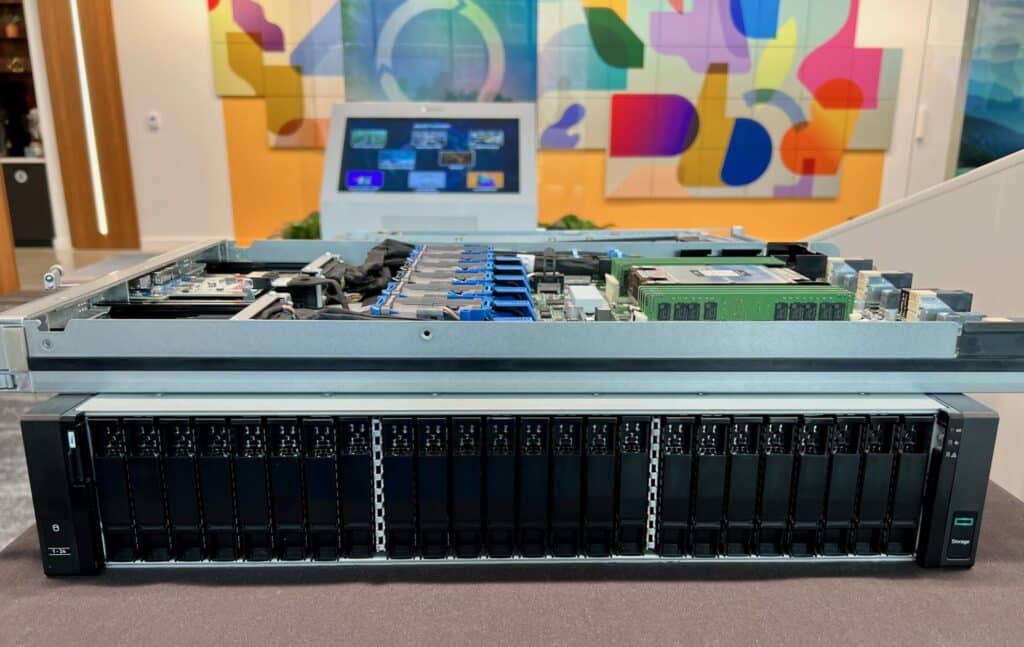New block and file services highlighted the HPE GreenLake Storage Day. While HPE emphasizes the operational and management benefits of making these services available in GreenLake, we’re interested in the new universal hardware platform that sits behind the scenes – the HPE Alletra MP storage server.
New block and file services highlighted the HPE GreenLake Storage Day. While HPE emphasizes the operational and management benefits of making these services available in GreenLake, we’re interested in the new universal hardware platform that sits behind the scenes – the HPE Alletra MP storage server.
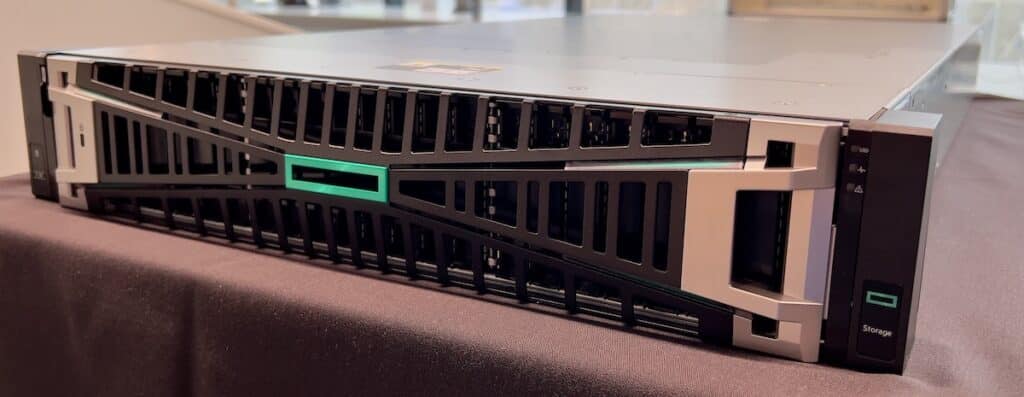
HPE Alletra MP
HPE Alletra MP
What the Alletra MP platform gives HPE is a purpose-built storage server solution that is flexible enough to handle a variety of workloads like the GreenLake storage services. Most of us in enterprise IT have had some exposure to supply chain issues during the recent pandemic. HPE, of course, was not immune to this and decided the faster they could pivot off of dedicated SAN storage hardware, the better.
While we’re seeing HPE put the Alletra MP server to work first in GreenLake, HPE obviously intends to leverage Alletra hardware platforms for their storage offerings in the future. The Alletra systems benefit a good deal from their ProLiant heritage, but are tuned for the specific needs of storage I/O.
Before MP, HPE had started rebranding the Apollo storage line to Alletra. We saw this most recently in the Alletra 4110 and 4120 platforms launched earlier this year. The Alletra 4110 is a 1U all-NVMe storage server that supports up to 20 E3.S or SFF NVMe SSDs (double-stacked backplane).
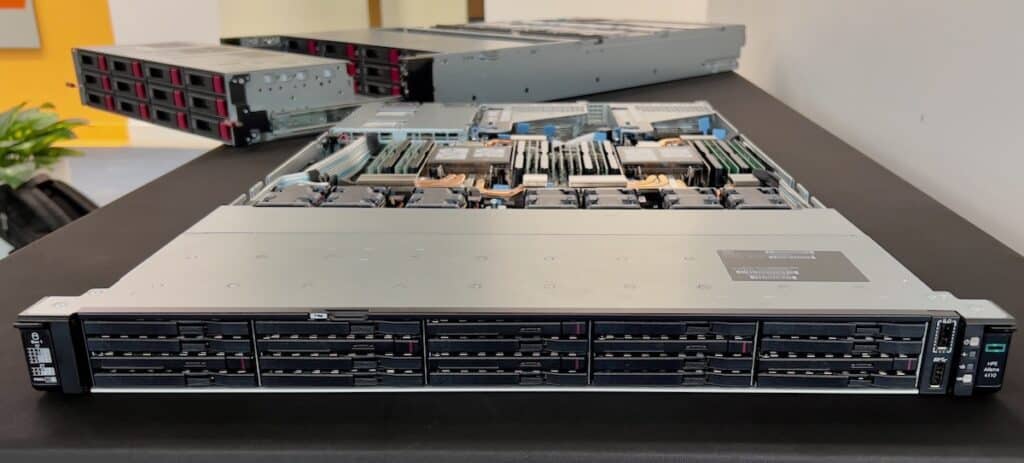
HPE Alletra 4110 and 4120
The Alletra 4120 is a 2U hybrid-NVMe storage server that supports up to front 24 LFF drives with 4 LFF, 12 E3.S or 6 SFF in the rear, and up to front 48 SFF drives with 12 E3.S or 6 SFF in the rear
While those storage servers have an interesting density story, they’re both simple single server, single-node designs. What Alletra MP does is bring a more SAN-friendly, dual-node architecture to market with support for 24 U.3/U.2 NVMe SSDs. While it would have been fun to see a dense E3.S platform with the MP, the ecosystem of SSDs isn’t there yet in terms of qualified dual-port drives. That said, dissociating the underlying software for block and file from the hardware gives HPE a ton of flexibility for the future to tune hardware platforms just the way they like for GreenLake and the channel partners that pick up the Alletra servers for their own SDS solutions.

HPE Alletra MP Rear
Swinging around the back of the HPE Alletra MP server, we start to get a better view of how this platform comes together. On either side of the rear of the chassis are power supplies. Above the power supply on the left, there’s an extra bit, a chassis identification module, which tells GreenLake how this particular Alletra MP is configured (block or file presently). In the center are the twin compute nodes, each powered by a single AMD EPYC processor.
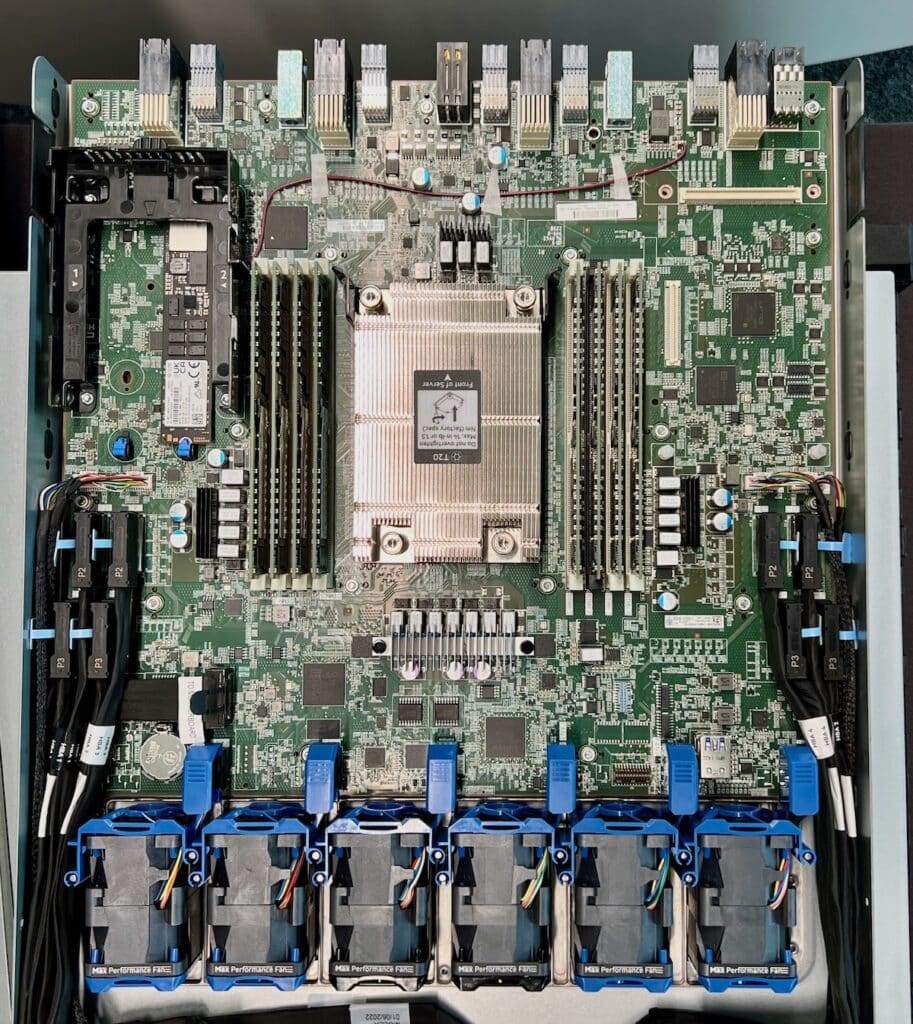
HPE Alletra MP Motherboard
As we take a closer look at the Alletra MP motherboard, we can see the fan bank at the rear of the server pulling air over the AMD CPU, 8 DIMM slots, and M.2 boot drives. The fans, in conjunction with those in the second node, would also cool the NVMe SSDs in the front of the unit and the I/O cards on the other side of the fans.
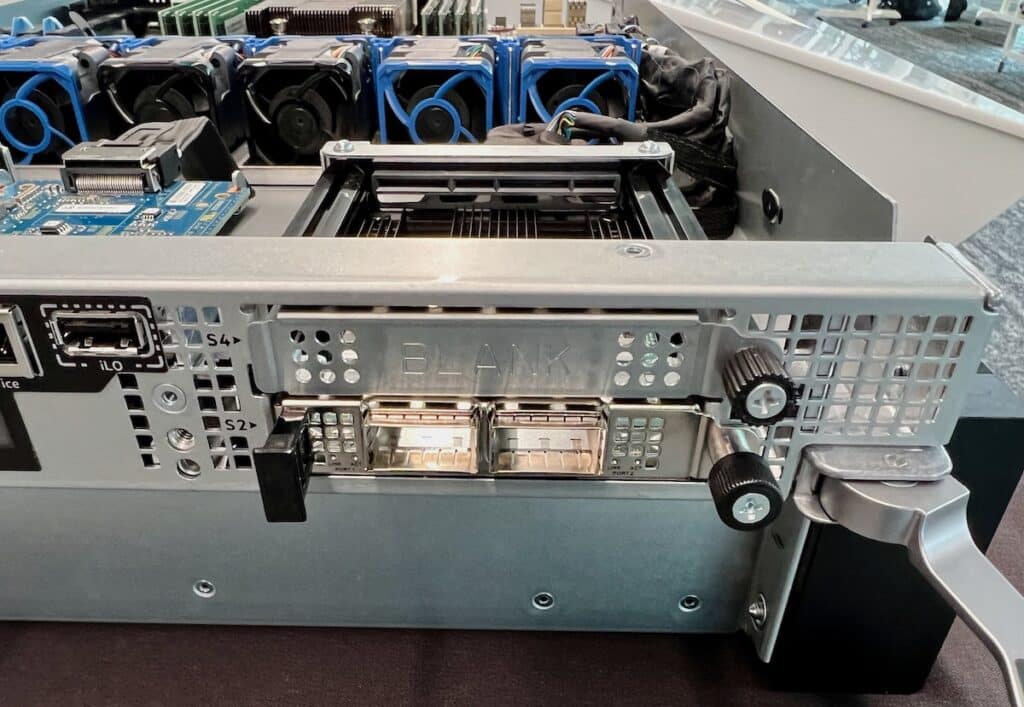
HPE Alletra MP I/O Modules
Each of the Alletra MP nodes has four OCP slots, giving HPE plenty of options when configuring these nodes for I/O. Today that usually means FibreChannel cards for the GreenLake block storage services and fast Ethernet for file storage. But there could be cases where both types are used or something else in those OCP slots entirely, depending on the customer’s need. Between the I/O banks is a dedicated HPE iLO card for out-of-band server management.
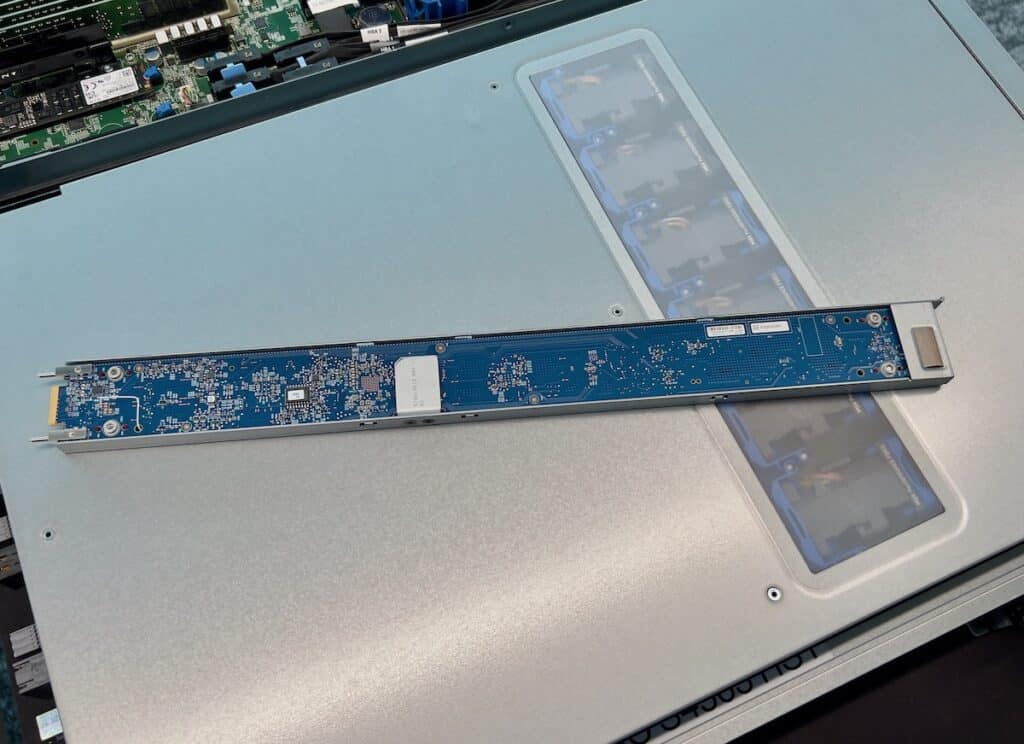
HPE Alletra MP Chassis ID Module
As mentioned, each Alletra MP chassis contains this lengthy ID module (extraction video on YouTube), which tells the HPE GreenLake platform about the underlying nodes and their persona. Today that means this is a block or file chassis, but in the future, these ID modules can handle whatever HPE comes up with next.
While most of the Alletra MP hardware will remain the same regardless of its use with GreenLake, there are some differences in the initial block and file offerings. Some of those are related to the underlying software, like file needing a couple of SCM SSDs, and others could be IO related.
HPE GreenLake for File Storage
GreenLake file storage is a scale-out file storage system provided by VAST Data. Fundamentally the VAST solution includes compute nodes that do most of the heavy lifting and data storage nodes that ensure availability. In this case, the hardware stack includes HPE Alletra MP Compute, HPE Alletra MP JBOFF, and HPE Aruba 8325 data center switches. We have a lengthy podcast with VAST Data if you care to learn more about their architecture.
| Specification | Value |
|---|---|
| Base Chassis Shared between Compute and Data Enclosures | 2U |
| Number of IOMs per Chassis | 2 |
| Cores per IOM Compute/Data | 32 / 8 |
| Memory per IOM Compute/DATA | 256G / 64G |
| Host Ports per IOM (Compute) | 2 |
| Fabric Ports per IOM | 2 |
| NVMe SSDs per Chassis | 20 (w/ 4 slots dedicated to persistent SCM NVME Drives) |
| Raw capacity (2-switch Fabric) | 154TB to 3,388TB |
| Usable capacity (2-switch Fabric) | 220TB to 3,007PB |
| Effective capacity | 5-10+PB (Default similarity reduction of 2:1 used for basic sizing) |
| Drive | 7.68/15.36TB NVMe SFF SSD |
| Host Connectivity | 10/25/40/100 Gb Ethernet |
| Max # of Enclosures (based on storage fabric configuration) | 2-switches -14 4-switches –12 – Designed as basic Leaf & Spine configuration 6-switches –24 8-switches –36 10-switches -48 |
| Drive | 7.68/15.36TB NVMe SFF SSD |
| Host Connectivity | 10/25/40/100 Gb Ethernet |
A few things are worth noting in this GreenLake file configuration with VAST Data. HPE backs this with six nines of reliability. It’s important to understand also that this solution scales into the exascale range without issue. HPE still needs to build a cluster that large to complete the required validation. Additionally, HPE still needs to qualify a 30.72TB SSD part, but once they do, all of this capacity per node stats will more or less double.
HPE GreenLake for Block Storage
HPE GreenLake for Block Storage is disaggregated, scale-out block storage with 100% availability guaranteed, clearly designed for mission-critical applications. For this service, HPE Alletra MP storage servers are the building blocks, in conjunction with FibreChannel switching from Brocade.
| Specification | 8-core | 16-core |
|---|---|---|
| Base Chassis | 2U | 2U |
| Number of Nodes | 2 | 2 |
| CPUs per Node | 1 | 1 |
| Memory per Node | 256 GB | 256 GB |
| Maximum Number of slots per Node | 4 | 4 |
| Maximum Host Ports per Node | 8-ports | 8-ports |
| Fibre Channel Host Ports per Node | 0-8 ports | 0-8 ports |
| Max Number of NVMe SSDs per Chassis | 24 | 24 |
| Max Raw Capacity per Chassis | 368 TB / 328.5TiB | 368 TB / 328.5TiB |
| Max Effective Capacity2 per Chassis | 1099TB / 1000TiB | 1099TB / 1000TiB |
Here you can see a little more of the node configuration flexibility with two different core counts. Just as with file, the MPs used here top out at 15.36TB SSDs, meaning there’s still a big capacity jump potential once HPE qualifies 30.72TB SSDs.
Final Thoughts
The HPE Alletra MP platform is a net win for customers, as it makes it a lot easier for HPE to support their GreenLake storage offerings today and their “standard” on-prem SAN and NAS offerings in the future. There’s little upside for dedicated hardware for each platform; HPE was wise to see that and start the move to a universal platform. And while it’s not entirely germane in the sense of GreenLake, having iLO there for management also brings a secure, hardened lifecycle update controller to the systems.
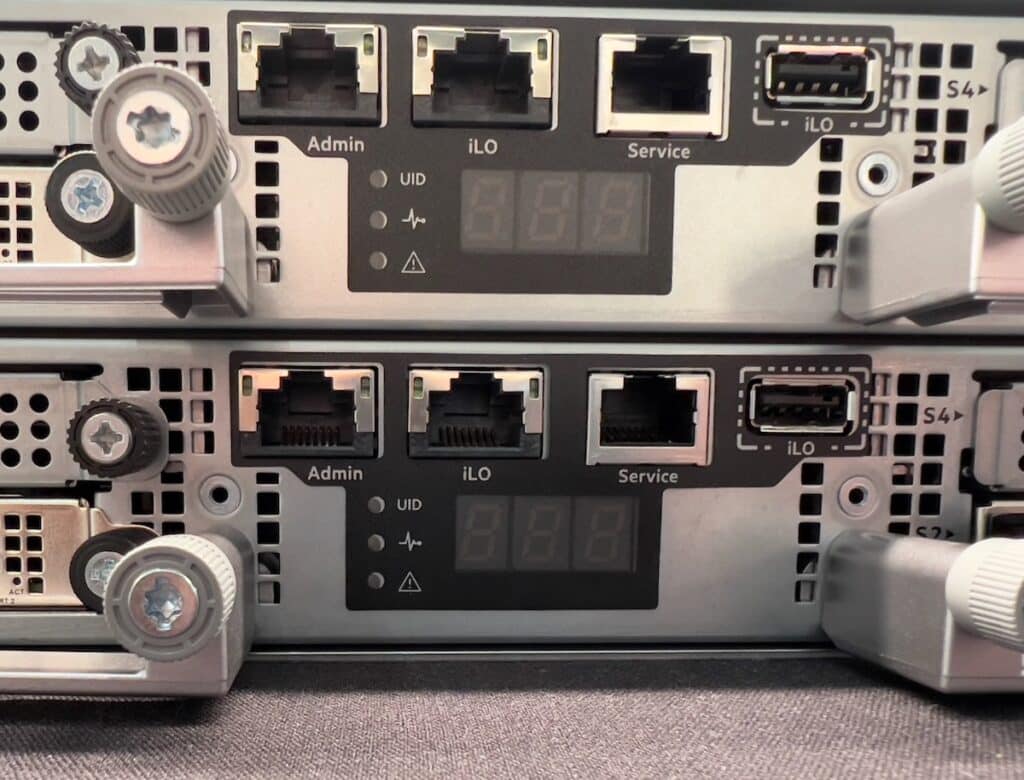
HPE Alletra MP iLO
Overall all of the Alletra hardware platforms we have interacted with have their own appeal. The 4110 has a great performance play, the 4120 offers a ton of density, and the new Alletra MP effectively unifies HPEs SAN and NAS hardware into one flexible platform. Overall these HPE storage servers are extremely compelling; we’re thrilled to see the commitment to hardware purpose-built for software solutions.
Engage with StorageReview
Newsletter | YouTube | Podcast iTunes/Spotify | Instagram | Twitter | TikTok | RSS Feed

